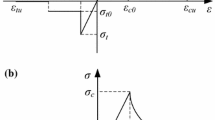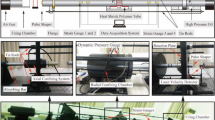Abstract
A modified split Hopkinson pressure bar (SHPB) numerical testing system is established to study the characteristics of rocks under simultaneous static and dynamic loading conditions following verification of the capability of the SHPB numerical system through comparison with laboratory measurements (Liao et al. in Rock Mech Rock Eng, 2016. doi:10.1007/s00603-016-0954-8). Three different methods are employed in this numerical testing system to address the contact problem between a rock specimen and bars. The effects of stand-alone static axial pressure, stand-alone lateral confining pressures, and a combination of them are analyzed. It is determined that the rock total strength and the dynamic strength are greatly dependent on the static axial and confining pressures. Moreover, the friction along the interfaces between the rock specimen and bars cannot be ignored, particularly for high axial pressure conditions. Subsequently, the findings are applied to determine the dynamic behavior of rocks with in situ stresses. The effects of the magnitude of horizontal and vertical initial stresses at varied depths and their ratios are investigated. It is observed that the dynamic strength of deep rocks increases with increasing depth or the ratio of horizontal-to-vertical initial stresses (K). The dynamic behavior of deeper rocks is more sensitive to K, and the rock dynamic strength increases faster with depth in areas with higher K.
















Similar content being viewed by others
References
Alves M, Karagiozova D, Micheli GB, Calle MAG (2012) Limiting the influence of friction on the split Hopkinson pressure bar tests by using a ring specimen. Int J Impact Eng 49:130–141. doi:10.1016/j.ijimpeng.2012.04.005
Asano N (1986) A penalty function type of virtual work principle for impact contact problems of two bodies. Bull JSME 29:3701–3709
Brown E, Hoek E (1978) Trends in relationships between measured in situ stresses and depth. Int J Rock Mech Min Sci 4:211–215
Cadoni E, Albertini C (2011) Modified Hopkinson bar technologies applied to the high strain rate rock tests. Advances in rock dynamics and applications. CRC Press, Boca Raton, pp 79–104
Chen W, Ravichandran G (1997) Dynamic compressive failure of a glass ceramic under lateral confinement. J Mech Phys Solids 45:1303–1328. doi:10.1016/S0022-5096(97)00006-9
Chen W, Yeh J (1988) A new finite element technique for dynamic contact problems with friction. J Theor Appl Mech 7:161–175
Christensen R, Swanson S, Brown W (1972) Split-Hopkinson-bar tests on rock under confining pressure. Exp Mech 12:508–513
Forquin P, Gary G, Gatuingt F (2008) A testing technique for concrete under confinement at high rates of strain. Int J Impact Eng 35:425–446
Frew DJ, Akers SA, Chen W, Green M (2010) Development of a dynamic triaxial Kolsky bar. Meas Sci Technol 21:105704
Goodman RE, Taylor RL, Brekke TL (1968) A model for the mechanics of jointed rock. J Soil Mech Found Div 94(3):637–660
Hartley RS, Cloete TJ, Nurick GN (2007) An experimental assessment of friction effects in the split Hopkinson pressure bar using the ring compression test. Int J Impact Eng 34:1705–1728. doi:10.1016/j.ijimpeng.2006.09.003
Li G, Tang C-A (2015) A statistical meso-damage mechanical method for modeling trans-scale progressive failure process of rock. Int J Rock Mech Min Sci 74:133–150
Li X, Zhou Z, Ye Z, Ma C, Zhao F, Zuo Y, Hong L (2008a) Study of rock mechanical characteristics under coupled static and dynamic loads. Chin J Rock Mech Eng 27:1387–1395
Li XB, Zhou ZL, Lok T-S, Hong L, Yin TB (2008b) Innovative testing technique of rock subjected to coupled static and dynamic loads. Int J Rock Mech Min Sci 45:739–748. doi:10.1016/j.ijrmms.2007.08.013
Li X, Gong F, Gao K, Yi S (2010) Test study of impact failure of rock subjected to one-dimensional coupled static and dynamic loads Chin. J Rock Mech Eng 29:251–260 (In Chinese)
Liao ZY, Zhu JB, Xia K, Tang CA (2016) Determination of dynamic compressive and tensile behaviors of rocks from numerical tests of split Hopkinson pressure and tension bars. Rock Mech Rock Eng. doi:10.1007/s00603-016-0954-8
Lindholm US, Yeakley LM, Nagy A (1974) The dynamic strength and fracture properties of dresser basalt. Int J Rock Mech Min Sci 11:181–191. doi:10.1016/0148-9062(74)90885-7
Liu JB, Yao L, Wang D (1994) A method for calculating the dynamic effect of dynamic and static friction on a contactable crack. Acta Mech Sin 26:494–502 (In Chinese)
Malvern LE, Jenkins DA, Tang T, McClure S (1990) Dynamic testing of laterally confined concrete. Micromechanics of Failure of Quasi-Brittle Materials. Barking Essex, Elsevier Appl Sci Publ Ltd
Rome J, Isaacs J, Nemat-Nasser S (2002) Hopkinson techniques for dynamic triaxial compression tests. In: Gdoutos EE (ed) Recent advances in experimental mechanics. Springer, pp 3–12
Tang CA (1997) Numerical simulation of progressive rock failure and associated seismicity. Int J Rock Mech Min Sci 34:249–261. doi:10.1016/S0148-9062(96)00039-3
Trautmann A, Siviour CR, Walley SM, Field JE (2005) Lubrication of polycarbonate at cryogenic temperatures in the split Hopkinson pressure bar. Int J Impact Eng 31:523–544. doi:10.1016/j.ijimpeng.2004.02.007
Yang YF, Li G, Liang ZZ, Tang CA (2015) Numerical investigation on crack branching during collision for rock-like material. Theor Appl Fract Mech 76:35–49. doi:10.1016/j.tafmec.2014.12.010
Zhang M, Wu HJ, Li QM, Huang FL (2009) Further investigation on the dynamic compressive strength enhancement of concrete-like materials based on split Hopkinson pressure bar tests. Part I: experiments. Int J Impact Eng 36:1327–1334. doi:10.1016/j.ijimpeng.2009.04.009
Zheng H, Liu DF, Lee CF, Yue ZQ (2004) A sophisticated node-pair model for interface problems. Comput Geotech 31:137–153. doi:10.1016/j.compgeo.2003.11.004
Zhou Z, Li X, Zou Y, Jiang Y, Li G (2014) Dynamic Brazilian tests of granite under coupled static and dynamic loads. Rock Mech Rock Eng 47:495–505
Zhu WC, Tang CA (2004) Micromechanical model for simulating the fracture process of rock. Rock Mech Rock Eng 37:25–56
Zhu WC, Bai Y, Li XB, Niu LL (2012) Numerical simulation on rock failure under combined static and dynamic loading during SHPB tests. Int J Impact Eng 49:142–157. doi:10.1016/j.ijimpeng.2012.04.002
Zhu JB, Deng XF, Zhao XB, Zhao J (2013) A numerical study on wave transmission across multiple intersecting joint sets in rock masses with UDEC. Rock Mech Rock Eng 46:1429–1442. doi:10.1007/s00603-012-0352-9
Acknowledgments
This research is financially supported by the Research Grant Council (No. 25201814), the National Natural Science Foundation of China (No. 41402241), and the National Basic Research Program of China (No. 2014CB047103).
Author information
Authors and Affiliations
Corresponding author
Rights and permissions
About this article
Cite this article
Zhu, J.B., Liao, Z.Y. & Tang, C.A. Numerical SHPB Tests of Rocks Under Combined Static and Dynamic Loading Conditions with Application to Dynamic Behavior of Rocks Under In Situ Stresses. Rock Mech Rock Eng 49, 3935–3946 (2016). https://doi.org/10.1007/s00603-016-0993-1
Received:
Accepted:
Published:
Issue Date:
DOI: https://doi.org/10.1007/s00603-016-0993-1




